
What are common depths for beginner scuba divers and how deep can a beginner go?
Common depths for beginner scuba divers are limited by their diver certification. For PADI this is 18 metres (60 feet) and BSAC 20 metres (66 feet). But it’s important as a beginner scuba diver you build your confidence and get confident underwater before going too deep.
Common depths for beginner scuba divers, as their diving experience is built, is between 9-20 metres (30-66 feet). As beginner divers become more experienced and advance to the next stage of certification, these common depths increase to between 18-30 metres (59-98 feet).
The best way to do more diving is to book yourself on a scuba diving liveaboard. You can check the latest and best deals on liveaboards using the following window:
When you scuba dive it’s important to consider how you are not in your natural breathing environment.
A dive is considered deep at depths greater than 18-20 metres (60-67 feet). The deeper the dive the more impact it has on you. This is due to increases in pressure as you descend. The deeper you dive the greater the risk of decompression sickness or the bends. Also, dives to depths in excess of 30 metres (98 feet) increase the chances of nitrogen narcosis and even the risk of oxygen toxicity.
Why is depth an important consideration for beginner scuba divers?
Firstly, before I explain more about common depths for beginner scuba divers, I want to explain why depth is important.
There are a few reasons why depth is important for beginner scuba divers. But I first need to explain the concept of depth and pressure underwater.
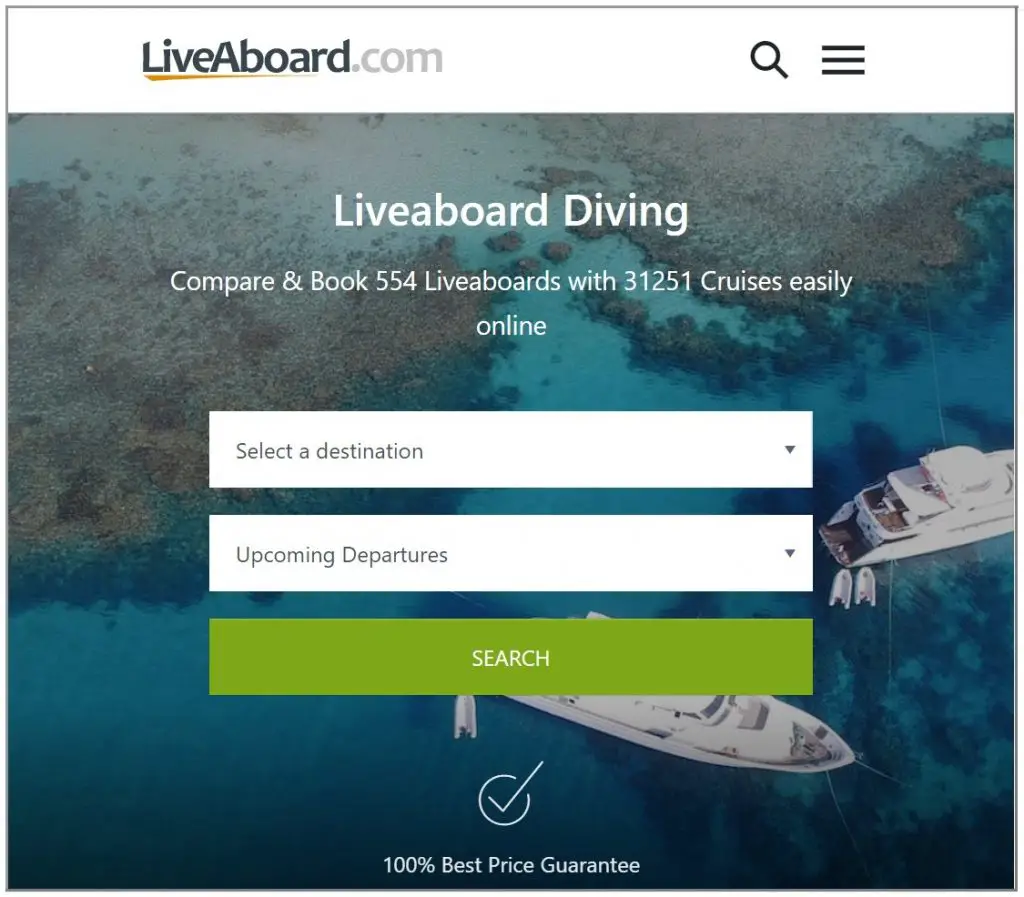
Understanding the concepts of pressure and depth underwater
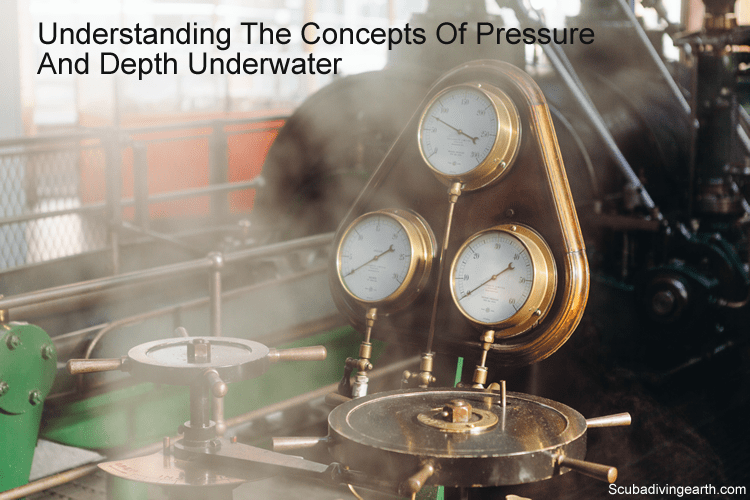
Most people understand that water is more dense than air. For example, most people understand that one litre (1.76 pints) of air is heavier than one litre of water.
The weight of air at sea level is referred to as one atmosphere, which is exerted though gravity. But once you descend under the water surface, the pressure of gravity is overtaken by the weight of water.
The deeper descend underwater the more pressure is exerted on your body.
More Reading: How long should you wait to fly after diving? (What’s safe?)
Pressure increases as you descend underwater
If you’ve ever dived to the bottom of a swimming pool in the deep end you’ve probably felt pressure on your ears. This is due to the increase in water pressure on your ear drums. The deeper you go the higher this pressure.
Scuba divers go much deeper than any swimming pool. This means the pressure changes will be that much greater.
If you descend to 10 metres (33 feet) the pressure at this depth is the equivalent of two atmospheres. Which is double what it is at sea level.
If you descend further to 20 metres (66 feet) the pressure of the water is equivalent to three atmospheres. Or three times the pressure at sea level. And so on.
Summary of water pressure down to 50 metres (164 feet) deep:
- 10 metres (33 feet): Two Atmospheres or 2-bar (1-bar = 1 atmosphere).
- 20 metres (66 feet): Three Atmospheres or 3-bar.
- 30 metres (100 feet): Four Atmospheres or 4-bar.
- 40 metres (131 feet): Five Atmospheres or 5-bar.
- 50 metres (164 feet): Six Atmospheres or 6-bar.
Why is depth and pressure of the water important to beginner scuba divers?
As a beginner scuba divers you have to learn new concepts when you learn to dive. Most of these new concepts are important to understand for safety reasons, many of which involve water pressure at depth.
Important concepts beginner scuba divers learn about depth and water pressure:
- Oxygen toxicity.
- Boyle’s Law.
- The bends or decompression sickness.
- Nitrogen narcosis.
1. Beginner scuba divers should understand oxygen toxicity risk at deeper depths
The amount of oxygen in atmospheric air (i.e. 21%) becomes toxic to humans at depths beyond about 60 metres (197 feet). The effects of oxygen toxicity may not happen immediately and will depend on circumstances. But at any depth beyond 60 metres scuba divers face an increasing risk of oxygen toxicity
Whilst beginner scuba divers won’t be going anywhere near this depth when they first start diving, it’s understanding the risk that’s important.
The majority of beginner scuba divers will breathe normal atmospheric air from their scuba tank. Or in other words it’s the same air as you are breathing as you read this article. Unless of course you’re reading underwater! The only difference is the air you breathe underwater is compressed air.
2. Boyle’s Law is an important concept to grasp as a beginner scuba diver
Boyle’s Law explains how the volume of a gas changes with the surrounding pressure. Put in simple terms:
- As the pressure surrounding a flexible container filled with gas is increased, the volume of gas will decrease.
- If the pressure surrounding a flexible container filled with gas is decreased, the volume of the gas will increase.
Assume this flexible container is a balloon, which is filled with air at the surface. This balloon is then taken to 10 metres underwater where the water pressure is double that at the surface. This balloon will be half its size at 10 metres.
As the balloon is brought back to the surface, it would return to its original size.
But now imagine replacing this balloon with your lungs. Your lungs are a bit like balloons. Your lungs don’t getting smaller as you descend as such. But instead they require more air to fill them to the same volume at the surface as you go deeper.
For example, at 10 metres your lungs will require twice the amount of air to fill them as they do at the surface. The deeper you go, the more air is required to fill your lungs. For example, at 20 metres (which is three atmospheres) you will need to breathe three times the volume of air to fill your lungs as you do at the surface.
Two concepts that are important to grasp by beginner divers when they first start diving in relation to Boyle’s Law:
- The deeper the dive, the more air you consume. Beginner scuba divers tend to consume more air until they get more experience. Which means if they were to dive deeper than 18-20 metres, their air may run out too quickly. If you want to master your air consumption you should read this article about 22 pro tips to conserve air when scuba diving.
- Not to hold your breath when you scuba dive. This is possibly the most important concept to understand about scuba diving as a beginner. Think about the balloon described above and imagine you are diving at 10 metres. If you fill your lungs with air at this depth and hold your breath and come to the surface, the air inside your lungs would want to double in size. But your lung expansion is limited by your rib cage. Your lungs would rupture and the air would leak, which is called a barotrauma. This injury is extremely dangerous and is life threatening.
- Your buoyancy reduces the deeper you descend. Your buoyancy is decreased as you go deeper because your exposure suit and air spaces get squeezed. Beginner scuba divers learn to compensate for their reduced buoyancy by adding air to their buoyancy control device (BCD).
3. Beginner scuba divers learn the important relationship between the bends or decompression sickness and depth
78% of air breathed is nitrogen. At depth and because of the additional pressure, this nitrogen is absorbed into your body’s tissues in greater amounts. It is these increased levels of nitrogen that need to be considered when you ascend from depth.
As you ascend from depth the water pressure reduces. As the pressure reduces, and if it reduces too quickly, the dissolved nitrogen will form into bubbles. The pressure will only reduce too quickly if you ascend too quickly. If you ascent too quickly you would ‘fizz-up.’ This ‘fizzing-up‘ is referred to as either decompression sickness or the bends.
Decompression sickness is caused by these small bubbles of nitrogen forming inside the body. The severity of decompression sickness and any resulting injury depends on the number of bubbles and where they form inside the body.
The deeper you go the greater the pressure. The greater the pressure the more nitrogen is dissolved. Also, the deeper you go the faster the nitrogen is absorbed by your body too.
You learn to ascend slowly from depth to allow your body to decompress. Which means the dissolved nitrogen is slowly decompressing from your body.
As you progress with your diving experience you may need to include decompression stops,
Important additional reading for beginner scuba divers includes decompression sickness factors.
4. Beginner divers might need to consider nitrogen narcosis as they progress and begin to dive deeper
At depths of 30 metres (66 feet) or more the excess nitrogen absorbed into your body can cause nitrogen narcosis.
Not all scuba divers are affected by nitrogen narcosis. But those that are affect can react in different ways. Some scuba divers will feel drunk and behave in strange and funny ways. Whilst others can be overcome with anxiety and fear or become extremely depressed.
Nitrogen narcosis is only a concern when you’ve progress your diver training. Which for PADI is to Advanced Open Water Diver and 30 metres (98 feet). Or for BSAC to Sport Diver and 35 metre (115 feet).
How deep do beginner scuba divers go and what are common depths?
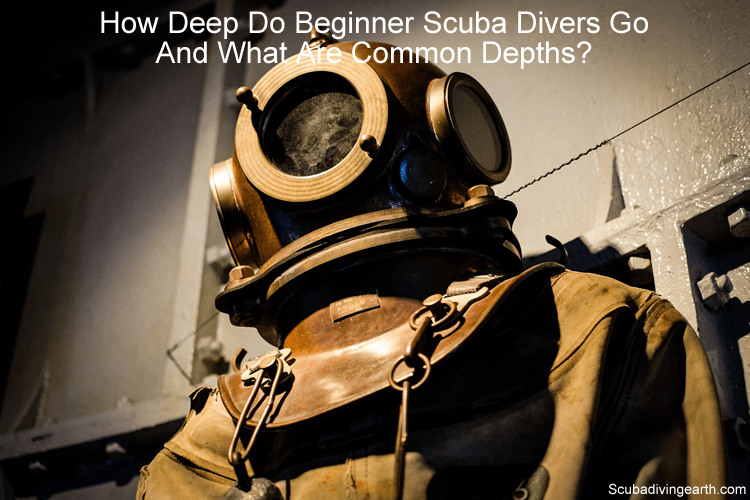
Beginner scuba divers commonly start scuba diving training in a swimming pool to a maximum of 3-4 metres (12 feet) or in shallow sheltered water to 9-10 metres (30-33 feet). Sheltered could mean a lake or a shallow reef dive without tidal currents.
Once you progress to the practical lessons of diver training to get scuba certified you normally dive to depths of between 10-20 metres (33-66 feet).
PADI Open Water Diver beginner diver depths
PADI Open Water Diver certifies you to dive to a depth of 18 metres (60 feet). You are advised to build your experience at this level by diving as many dives as you can before moving on to the next diver certification level.
Did you know the best way to build your diver experience is to dive from a liveaboard. You dive up to three dives per day (sometimes 4 dives) on a liveaboard.
Scuba diving liveaboards table
This list of liveaboards is in descending customer rating order, followed by Scuba Diving Luxury Rating (SDE Lux Rating, see below), so the liveaboards with the highest customer rating and the best SDE lux rating will be at the top of the list. If you want to change the list order, use the “Sort by” dropdown below.
| Discover Liveaboard | Customer Rating | SDE Lux Rating % | Flexible Booking | Dive Courses | Dietary Requirements | Nitrox | Country | |
|---|---|---|---|---|---|---|---|---|
 |
Review: MV Tiburon Explorer; Book: MV Tiburon Explorer | 9.7 | 85% | NO | NO | YES | YES | Galapagos |
 |
Review: Mutiara Laut; Book: Mutiara Laut | 9.7 | 85% | YES | YES | YES | YES | Indonesia |
 |
Review: Carpe Diem; Book: Carpe Diem | 9.7 | 69% | YES | YES | YES | NO | Indonesia |
 |
Review: MV Scubaspa Yang; Book: MV Scubaspa Yang | 9.6 | 87% | YES | YES | YES | YES | Maldives |
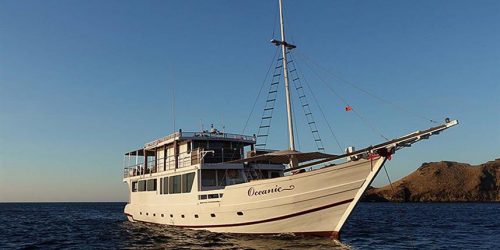 |
Review: SMY Oceanic; Book: SMY Oceanic | 9.6 | 87% | YES | YES | YES | YES | Indonesia |
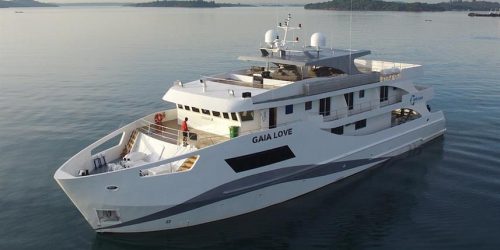 |
Review: MV Gaia Love; Book: MV Gaia Love | 9.6 | 87% | NO | YES | YES | YES | Indonesia |
 |
Review: MSY Tiger Blue; Book: MSY Tiger Blue | 9.6 | 81% | YES | YES | YES | NO | Indonesia |
The Scuba Diving Earth Luxury Rating (SDE Lux Rating) is explained on each liveaboard review when you click the “Discover Liveaboard” link, and is my own Liveaboard Luxury Rating I’ve assigned to all liveaboards. Choosing between liveaboards is helped by customer scores, and if you get stuck choosing between two or three liveaboards, where each one has a high customer score out of 10, you can use the SDE Luxury Rating to help narrow down your choice.
Think about it like using Booking.com when searching for the best hotel. Booking.com also use a customer score where each customer rates hotels out of 10. This is similar to the liveaboard customer rating, which is also rated out of 10. But let’s say you only like to stay in hotels rated 8 and above on Booking.com, but you also want the hotel to have WIFI or parking, or to have a swimming pool etc. The features each hotel has is usually secondary to the score out of 10.
PADI are the largest scuba diving organisation in the world. Your PADI Open Water Diver certification will be recognised anywhere you choose to dive. Open Water Diver training includes theory exams and underwater training.
The next stage in your training with PADI is Advanced Open Water Diver or AOWD. AOWD certifies you to a depth of 30 metres (100 feet).
How deep can you dive with BSAC Ocean Water certification?
BSAC Ocean Diver certifies you to dive to 20 metres (66 feet). The same applies to diving with BSAC. Which is you should build your experience slowly and only dive deeper when you’ve dive more and have more confidence.
The next stage in your beginner diver training Sport Diver. Sport Diver certifies you to dive to 35 metres (115 feet).
Pro tip: Dive at least 20 dives before progressing beyond the Open Water or Ocean Diver stage
Dive at least 20 dives to no more than 18 metres as an Open Water Diver or 20 metres as an Ocean Diver, before you progress to the next stage. It’s not a race and remember that scuba diving can be dangerous if the water is not respected.
Things can go wrong. If you don’t have the experience when it does go badly wrong you could put yourself or your buddy at risk.
More Reading: How do I get a dive buddy? (5 easy ways to find a dive buddy)
PADI only require you to complete 4 open water dives at the Open Water Diver stage. Plus a further 5 dives on the Advanced Open Water Diver training. This makes a total of 9 dives. I suggest this is too few. It’s rules like this where PADI get the reputation for their nickname: “Put Another Dollar In.”
For example, SSI require 24 logged dives before you can to progress to their equivalent Advanced Open Water Diver stage. This is more sensible.
Also, using the term ‘Advanced‘ in the name is misleading. A beginner diver who’s dived 9 times is not an advance diver. For example, an Advanced Diver at BSAC recommends at over 100 dives. Plus significant extra training.
How many dives do you need for Open Water Diver certification?
You need to dive four times to be Open Water Diver certified with PADI.
For BSAC Ocean Diver you also need to complete at least 4 open water dives. But with BSAC you are also required to carry out at least five pool sessions or sheltered water dives too.
More Reading: PADI vs BSAC (Which diving qualification is better PADI or BSAC?)
How long does it take to become a certified scuba diver?
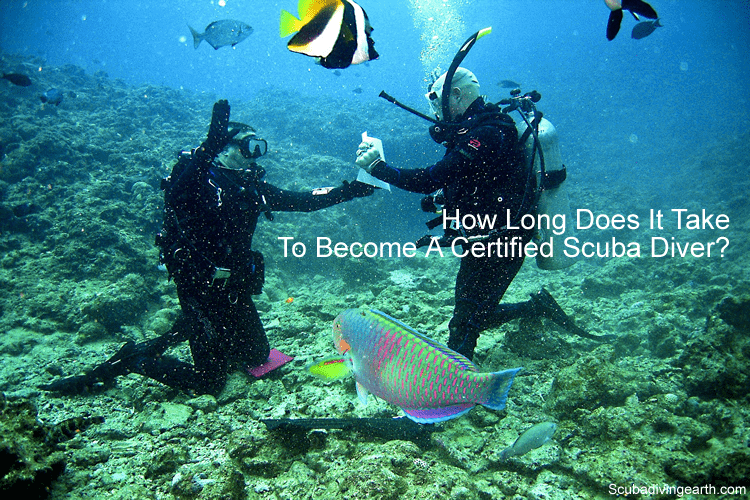
To become a certified scuba diver it normally takes between 2-3 days in total. But the time it takes to become a certified scuba diver will depend on you. If you’re a confident swimmer and quickly master mask clearing you will be certified in this time.
As mask clearing is a vital skill to learn, you may like to read this article about how to clear your mask like a pro.
Your theory lessons and exam is best done before the practical water-based lessons and dives.
How deep is the average scuba dive?
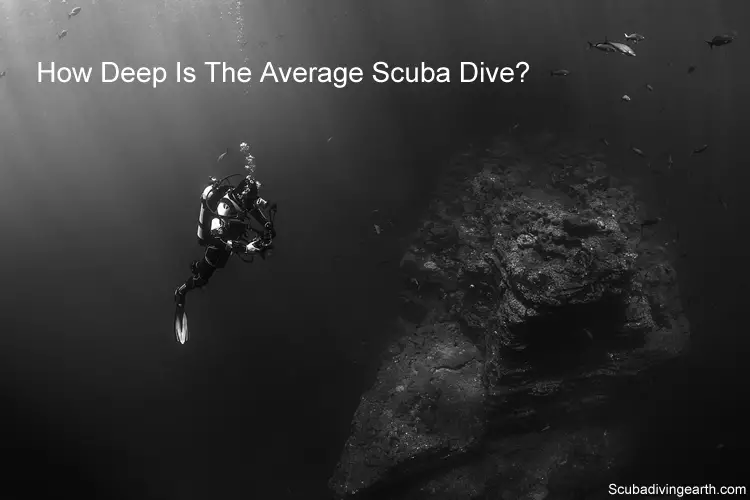
The average scuba dive is between 15 and 25 metres (49-82 metres) deep. Most recreational scuba divers don’t dive much deeper than 40-50 metres (131-164 feet). How deep you are certified to dive depends on the organisation you trained with.
If you are interested in diving deeper, you might want to read this article about what deep diving is all about. Included in this article are 26 tip pro tips. But always remember that diving deep or deeper is not necessarily better.
Often times there’s more to see in the shallower depths. For example:
- This article on Bahamas tiger shark diving at Tiger Beach you can dive with tiger sharks at just 6-10 metres (20-33 feet).
- One of my favourite dives in Barbados is at a depth of just 10 metres (33 feet). The dive I love is the Cement Works where on one dive I counter over 30 seahorses. Read this article about diving in Barbados and if it’s any good.
- Some of the best diving in the UK is in the Farne Islands with seals. These dives are mostly no deeper than 14-15 metres (46-49 feet).
Deep may be different, but not necessarily better.
But having said that, there are equally some excellent scuba dives at depth too. There are many ship wrecks at depth.
How deep can you dive before being crushed?
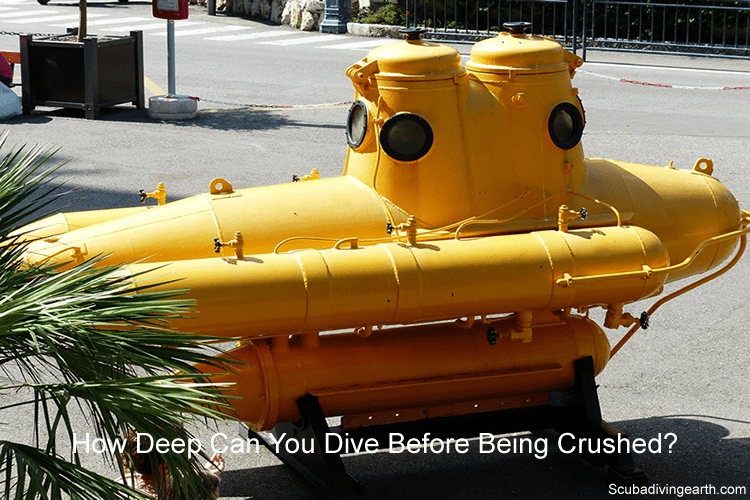
In a submarine man has been able to dive to a depth of 10,930 metres (35,858 feet) below the surface of the ocean. This is as deep as the oceans goes on planet earth.
But also, with the right equipment like a Newtsuit, developed by Canadian scuba diver Phil Nuytten, divers are able to dive extremely deep. The Newtsuit functions like a submarine. Thus allowing the diver to work at normal atmospheric pressure, even at depths of 300 metres (1,000 feet).
The deepest scuba diver
A scuba diver made a record-breaking scuba dive in the Red Sea off the coast of Dahab, Egypt.
The dive was done by Ahmed Gabr, who plunged about 332 metres (1,090 feet). This is the deepest scuba dive ever and at that depth he wasn’t crushed.
More Reading: What should you not do after scuba diving (11 must NOT do’s after diving)
I hope you enjoyed this article about what are common depths for beginner scuba divers
I’d love to hear from you. Tell us about your adventures of diving and snorkeling, in the comments below. Please also share your photos. Either from your underwater cameras or videos from your waterproof Gopro’s!
If this article hasn’t answered all of your questions. If you have more questions either about snorkeling or scuba diving (or specifically about what are common depths for beginner scuba divers), please comment below with your questions.
There will also be many more articles about scuba diving (and snorkeling) for you to read and learn about these fabulous sports.
Have fun and be safe!

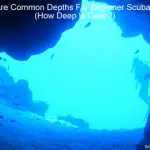
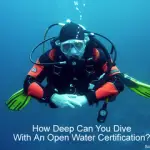
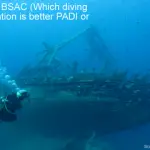
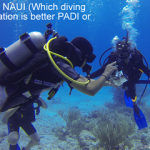
My son 13 wants to see a statue that is resting at 120 feet in a lake in Minnesota! How would I go about allowing him to learn to dive to this depth? I suffer from claustrophobia and Dived as a child With my own father. I had one bad experience and never did subs again. How can I hope my son to enjoy this with out giving him the same fear I have?
How can I allow my son to dive in a Minnesota Lake at a depth of 120 feet safely
Hello Loretta, thank you for your questions. Before he dives to any depth, he needs to get certified to dive first. As you live in the US and in particular Minnesota, I suggest you search on ‘learn to dive in Minnesota.’
Also, as you are in America, you want to make sure the place you take your son is a recognised dive organisation like PADI or NAUI, as these are US-based diving organisations (see link below also). Please obviously go with your son and ask all the questions you need in order to feel comfortable with the dive instructors you meet. You need to satisfy yourself that your son will be in safe hands. But this should normally be the case with any reputable diving organisation.
Perhaps also ask to speak with at least one or two others that have trained to scuba dive with them.
Once your son is certified, and if for example this is with PADI, your son will first be an ‘Open Water Diver.’ This will only permit him to dive to 60 feet (18 metres). For him to progress to diving to 120 feet or 36-37 metres, he will need to progress through to an ‘Advanced Open Water Diver,’ where he’ll be able to dive to 100 feet (30 metres). But this still will not allow him to dive to the statue you describe in the lake.
To be able to dive to the depth you are describing, your son needs to complete the PADI deep diver course (see this link here: https://www.padi.com/courses/deep-diver).
But please make sure that above all, your son does not rush to go to depth. I always recommend that he takes it slowly. Learn to dive first, get qualified to the first stage of ‘Open Water Diver.’ Have him get at least 20 dives under his belt at this certification level. Then have him progress to the next level, then add more diving experience to his dive log, and so on.
It’s unfortunate that you had a bad experience. If you haven’t already done so, you are best to not describe this experience to your son. You don’t want to put any suggestions to him about this if you can help it.
You may even consider getting therapy for your bad experience (if you don’t mind my saying). This would allow you to begin again and start to dive once more. This way you could enjoy the whole experience and learn with your son.
When my daughter learnt to dive, although I was already diving myself and an instructor, I had someone else teach her in Cyprus, but I was with her during each of the sessions and I enjoyed the time with her on her first few dives. This was great to experience. See if you could do this for you and for your son, as that would be a great experience for you both.
Please also have a read of this page, especially the main heading ‘Here are the nine reputable diving organisations around the world’ here: https://www.scubadivingearth.com/types-of-scuba-diving-certification-you-must-have-to-dive/
If you have any further questions, please further comment. But also, please update me with your son’s progress. I’d love to hear how he gets on. Also, let me know how you get on too.